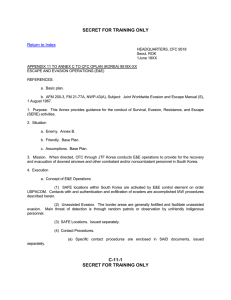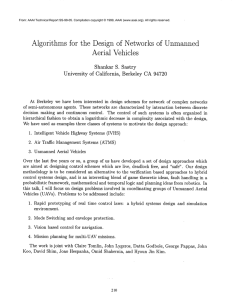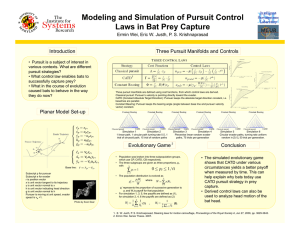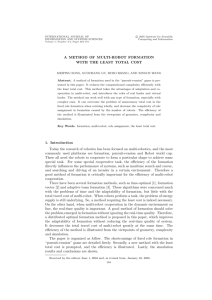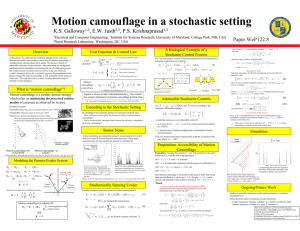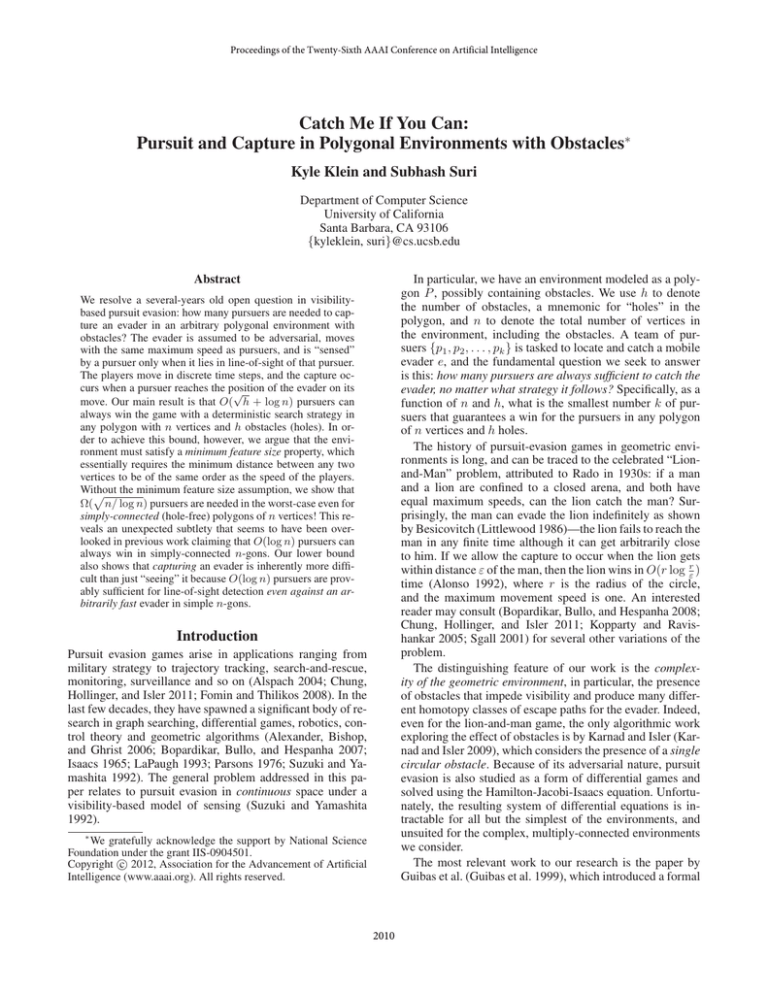
Proceedings of the Twenty-Sixth AAAI Conference on Artificial Intelligence
Catch Me If You Can:
Pursuit and Capture in Polygonal Environments with Obstacles∗
Kyle Klein and Subhash Suri
Department of Computer Science
University of California
Santa Barbara, CA 93106
{kyleklein, suri}@cs.ucsb.edu
Abstract
In particular, we have an environment modeled as a polygon P , possibly containing obstacles. We use h to denote
the number of obstacles, a mnemonic for “holes” in the
polygon, and n to denote the total number of vertices in
the environment, including the obstacles. A team of pursuers {p1 , p2 , . . . , pk } is tasked to locate and catch a mobile
evader e, and the fundamental question we seek to answer
is this: how many pursuers are always sufficient to catch the
evader, no matter what strategy it follows? Specifically, as a
function of n and h, what is the smallest number k of pursuers that guarantees a win for the pursuers in any polygon
of n vertices and h holes.
The history of pursuit-evasion games in geometric environments is long, and can be traced to the celebrated “Lionand-Man” problem, attributed to Rado in 1930s: if a man
and a lion are confined to a closed arena, and both have
equal maximum speeds, can the lion catch the man? Surprisingly, the man can evade the lion indefinitely as shown
by Besicovitch (Littlewood 1986)—the lion fails to reach the
man in any finite time although it can get arbitrarily close
to him. If we allow the capture to occur when the lion gets
within distance ε of the man, then the lion wins in O(r log rε )
time (Alonso 1992), where r is the radius of the circle,
and the maximum movement speed is one. An interested
reader may consult (Bopardikar, Bullo, and Hespanha 2008;
Chung, Hollinger, and Isler 2011; Kopparty and Ravishankar 2005; Sgall 2001) for several other variations of the
problem.
The distinguishing feature of our work is the complexity of the geometric environment, in particular, the presence
of obstacles that impede visibility and produce many different homotopy classes of escape paths for the evader. Indeed,
even for the lion-and-man game, the only algorithmic work
exploring the effect of obstacles is by Karnad and Isler (Karnad and Isler 2009), which considers the presence of a single
circular obstacle. Because of its adversarial nature, pursuit
evasion is also studied as a form of differential games and
solved using the Hamilton-Jacobi-Isaacs equation. Unfortunately, the resulting system of differential equations is intractable for all but the simplest of the environments, and
unsuited for the complex, multiply-connected environments
we consider.
The most relevant work to our research is the paper by
Guibas et al. (Guibas et al. 1999), which introduced a formal
We resolve a several-years old open question in visibilitybased pursuit evasion: how many pursuers are needed to capture an evader in an arbitrary polygonal environment with
obstacles? The evader is assumed to be adversarial, moves
with the same maximum speed as pursuers, and is “sensed”
by a pursuer only when it lies in line-of-sight of that pursuer.
The players move in discrete time steps, and the capture occurs when a pursuer reaches the position
of the evader on its
√
move. Our main result is that O( h + log n) pursuers can
always win the game with a deterministic search strategy in
any polygon with n vertices and h obstacles (holes). In order to achieve this bound, however, we argue that the environment must satisfy a minimum feature size property, which
essentially requires the minimum distance between any two
vertices to be of the same order as the speed of the players.
Without
p the minimum feature size assumption, we show that
Ω( n/ log n) pursuers are needed in the worst-case even for
simply-connected (hole-free) polygons of n vertices! This reveals an unexpected subtlety that seems to have been overlooked in previous work claiming that O(log n) pursuers can
always win in simply-connected n-gons. Our lower bound
also shows that capturing an evader is inherently more difficult than just “seeing” it because O(log n) pursuers are provably sufficient for line-of-sight detection even against an arbitrarily fast evader in simple n-gons.
Introduction
Pursuit evasion games arise in applications ranging from
military strategy to trajectory tracking, search-and-rescue,
monitoring, surveillance and so on (Alspach 2004; Chung,
Hollinger, and Isler 2011; Fomin and Thilikos 2008). In the
last few decades, they have spawned a significant body of research in graph searching, differential games, robotics, control theory and geometric algorithms (Alexander, Bishop,
and Ghrist 2006; Bopardikar, Bullo, and Hespanha 2007;
Isaacs 1965; LaPaugh 1993; Parsons 1976; Suzuki and Yamashita 1992). The general problem addressed in this paper relates to pursuit evasion in continuous space under a
visibility-based model of sensing (Suzuki and Yamashita
1992).
∗
We gratefully acknowledge the support by National Science
Foundation under the grant IIS-0904501.
c 2012, Association for the Advancement of Artificial
Copyright Intelligence (www.aaai.org). All rights reserved.
2010
√
that O( h + log n) pursuers are always sufficient to catch
the evader in a multiply-connected polygon of n vertices and
h obstacles (holes). When the polygon is simply-connected
(hole-free), this yields an O(log n) bound for the number
of pursuers. The pursuers’ winning strategy is deterministic,
and succeeds in polynomial time.
framework and analysis of visibility-based pursuit in complex polygonal environments. In order to make the problem
tractable, however, Guibas et al. make one crucial simplifying assumption: evader loses if it is “seen” by any pursuer.
That is, the pursuers need to only detect the presence of the
evader, and not physically catch it. With this weaker requirement of “capture,” Guibas et al. manage to prove several interesting combinatorial bounds, including that Θ(log
n) pur√
suers in a simply-connected polygon, and Θ( h + log n)
pursuers in a polygon with h holes (obstacles), are always
sufficient and sometimes necessary. In fact, these bounds
hold even if the evader can move arbitrarily faster than the
pursuers.
In the intervening twelve or so years, there has been little progress on extending these “detection” of evader bounds
to physical “capture” of the evader. In fact, there are only a
handful of small results to speak of. First, Isler et al. (Isler,
Kannan, and Khanna 2005) show that in simply-connected
polygons, two pursuers can capture the evader in expected
polynomial time using a randomized strategy. A deterministic version of their strategy works with O(log n) pursuers.
Recently, and almost simultaneously, two groups (Bhadauria and Isler 2011) and (Klein and Suri 2011) proved that if
the location of the evader is always known to the pursuers,
e.g., using an ubiquitous camera network, then 3 pursuers
are enough to win the game. Without these extreme conditions of unfair advantage to the pursuers, no non-trivial
upper bound on the number of pursuers necessary to win
the game is known. The main result of this paper is to resolve this question, and in the process uncover a mathematical subtlety that has been overlooked by previous work. In
particular, our paper makes the following contributions.
Preliminaries
Our pursuit evasion problem is set in a two-dimensional
closed polygonal environment P , with a total of n vertices
and h holes (where n includes the vertices of the holes). A
team of pursuers {p1 , p2 , . . . , pk } is tasked to locate and
catch an evader e. The evader and the pursuers have the
same maximum speed, which we assume to be one without loss of generality. Abusing the notation slightly, we also
denote the current positions of the players as pi and e. The
players’ sensing model is based on line-of-sight visibility:
a pursuer can see the evader only if the latter is in the pursuer’s line of sight. That is, a pursuer p sees the evader e
only if the line segment (p, e) does not intersect the boundary of the environment. The pursuers are assumed to operate
in a global communication model so that they can coordinate their moves, and share their knowledge of the evader’s
location.
The players take alternate turns, where all the pursuers
can move simultaneously on their turn. In each turn, a player
can move to any position that is within distance one of its
current location, under the shortest path metric, in the free
space (the region of the polygonal environment not occupied by holes). We assume that all the players know the
environment, and the pursuers do not know the strategies
or the future moves of the evader, although the evader may
have complete information about pursuers’ strategies. The
pursuers win if after a finite amount of time, some pursuer
becomes collocated with the evader. The evader wins if it
can evade indefinitely. The fundamental question we seek to
answer is this: what is the minimum value of k, the number
of pursuers, that guarantees a win for the pursuers?
We begin by establishing a lower bound that shows the
difficulty of capturing the evader in the general case, and
then introduce a natural geometric condition for the environment, called the minimum feature size, which allows us
to prove significantly better upper bounds.
Statement of Results
p
We first prove a general lower bound of Ω( n/ log n) for
the number of pursuers needed in the worst-case to catch an
equally fast evader in simply-connected (hole-free) polygons
of n vertices. This lower bound reveals an inconsistency
with the existing upper bound of O(log n) pursuers for the
same problem (Isler, Kannan, and Khanna 2005). In trying
to reconcile this inconsistency, we discovered that the previous upper bound makes some implicit assumptions about
the geometry of the environment, in particular the speed of
the players relative to the size of the environment. Our lower
bound shows that one needs to be careful about features of
the environment and not just the equality of the speed of the
evader and the pursuers.
We then show that a minimum feature size property of
the environment is sufficient to yield significantly better and
natural upper bounds for the capture problem. The minimum feature size of a polygonal environment is the minimum distance between any two vertices (using the shortest path metric in free space). We normalize the maximum
speed of the players to one, and require that the minimum
feature size of the environment to be at least one. We feel
that this condition naturally occurs in p
physical systems,
and its violation is the source of the Ω( n/ log n) lower
bound mentioned earlier. With this assumption, we show
A General Lower Bound
Without any restrictions on the environment or the speed of
the players, except that pursuers and evader have the same
maximum speed, we prove the following lower bound.
Theorem 1. There exist simply-connected p
(hole-free) polygons with n vertices that require at least Ω( n/ log n) pursuers to catch an equally fast evader.
Proof. We give an explicit construction that forces the
claimed number of pursuers. Our polygons correspond to
complete binary trees in which an n-node tree is mapped to a
simple polygon of at most 12n vertices. Each edge of the tree
T maps to a “corridor with a bend,” which we call an edge
2011
this largest component C on its next move. Since C is
pursuer-free, the entire component must be searched to locate and capture the evader. Each edge corridor has length
one, any pursuer moving at maximum speed can search at
most 4 log n + 1 < 5 log n nodes (the pursuer may be closer
than one to the first corridor searched, so we give that one
for free), and so the p pursuers collectively can search at
most 5p log n nodes of C.1 Thus, for the pursuers to capture
the evader on their move, the following inequality must be
satisfied:
corridor, and each vertex maps to a vertex corridor that interconnects the edge corridors of its incident edges. Figure 1
shows the construction for a binary trees with 4 leaves. We
now show that this polygon can always be constructed such
that the vertex corridors are no longer than edge corridors,
thereby ensuring that the length of a shortest path between
any two points in the polygon is at most 4 log n—such a path
visits at most 2 log n edge and vertex corridors each. We initially construct the polygon so that each edge corridor has
length 1, while the vertex corridors get progressively longer
at higher levels of the tree. Since the number of nodes at each
level is halved, the length of the vertex corridor doubles. Because the tree has height log n, the longest vertex corridor (at
the root) level has length Θ(n), and so the polygon can be
embedded on a O(n) × O(log n) size grid. Next, to achieve
the property that vertex corridors are shorter than edge corridors, we apply a scaling transform along the y-axis so that
all edge corridors are stretched by a factor L, where L is
the length of the longest vertex corridor before the scaling.
Finally, we scale the entire polygon down to make the edge
corridors one unit long, thus ensuring that the shortest path
between any two points of the polygon has length at most
4 log n.
(a)
5p·log n ≥ b
n−p
n−p
n − n/2
n
c−1 >
>
=
,
2(2p + 1)
5p
5p
10p
n
1/2
which leads to p ≥ ( 50 log
. (We have made no attempt
n)
to optimize the constant factor in our proof, and instead focused on a quick derivation of the asymptotic bound.) Since
the polygon corresponding to a n-node tree has at most 12n
vertices, we conclude that in the worst-case capturing
an
p
evader in a simply-connected n-gon requires Ω( n/ log n)
pursuers.
Remark: Our lower bound seems to contradict a result
of (Isler, Kannan, and Khanna 2005) that O(log n) pursuers
can always capture an equally fast evader. (Strictly speaking,
their result claims win for just two pursuers using a randomized strategy. However, the randomization is used only for
locating the evader, and so their solution can be made deterministic by performing localization using O(log n) pursuers (Guibas et al. 1999).) The source of the contradiction
is that Isler et al. implicitly assume that the environment
is much larger than the speed of the players. In “practice”
this is an eminently reasonable assumption—their choice of
speed or “step size” is an attempt to discretely approximate
the “continuous motion” of players. However, mathematically, this is unsatisfactory because precisely what properties
of the environment are needed is not made clear. In concrete
terms, their “proof” that each vertex of the polygon is the
“blocking vertex” at most once is not valid in general, with
the polygon of our lower bound construction (Fig. 1) being
a particular counter-example.
(b)
Figure 1: (a) A binary tree; (b) the corresponding polygon.
We
p now argue that this construction requires
Ω( n/ log n) pursuers to catch the evader, by presenting an evader strategy that avoids its capture with fewer
pursuers. Suppose that a certain number of pursuers, say
p, each with maximum speed 4 log n, are sufficient to win
against the evader, who also has the maximum speed of
4 log n. Let us first consider the line-of-sight visibility
of any pursuer. A pursuer in a vertex corridor can only
see within that corridor plus at most three edge corridors
incident to that vertex corridor. A pursuer in an edge
corridor can see that corridor plus at most one incident
vertex corridor. Therefore, the p pursuers collectively have
visibility of at most p vertex corridors and their 3p adjacent
edge corridors. An evader located in any other corridor is
invisible to the pursuers.
We now reason about evader’s strategy by considering
how the pursuers’ positions partition the tree T . Consider
deleting from the tree T the p vertices and their 3p adjacent edges corresponding to the corridors visible to the pursuers. This partitions the tree into at most 2p + 1 connected
components—each deletion splits one component into three,
thus increasing the component count by 2. By the pigeonhole principle, the largest component (call it C) must have
n−p
n−p
nodes, and at least b 2(2p+1)
c non-leaf nodes
at least 2p+1
(corridors); the bound on non-leaf node holds because we
have a binary tree. The evader’s strategy is to move into
In the remainder of the paper, we show that a simple geometric condition on the environment, which we call the
minimum feature size condition, allows us to circumvent the
lower bound of Theorem 1. In particular, we show that if
the environment is a simply-connected n-gon with minimum feature size, then O(log n) pursuers can always win
the game. Our main result, however, is to settle the complexity of pursuit evasion in polygonal environments with
holes, where no non-trivial bound was previously known.
Upper Bounds For Environments with
Minimum Feature Size
We begin with a definition of the minimum feature size.
1
In fact, our estimate is conservative because the edges corresponding to leaves must be searched too—however, it does not
change the asymptotics of the lower bound.
2012
(a)
(b)
(c)
(d)
this strategy. A polygon with n vertices, and any number of
holes, can be triangulated in O(n log n) time (de Berg et al.
1997). We reduce this O(n) size triangulation graph to an
O(h) size planar graph by repeatedly contracting each graph
vertex of degree 2, and deleting every vertex of degree one.
(See Figure 2.) In the end, each surviving vertex has degree
3, and Euler’s formula for planar graph implies that G has h
faces, at most 2h − 2 vertices, and at most 3h − 3 edges.
We use this graph G to recursively divide the environment into two parts, so that each part has a constant fraction
of the holes. In the base case we reach simply-connected
sub-polygons of P . Specifically, we use the following wellknown Planar Separator Theorem (Lipton and Tarjan 1977;
Djidjev 1982).
Figure 2: (a) A triangulation; (b) its dual graph; (c) the contracted dual; (d) illustration of the recursive strategy—two
separating triangles (shaded) break the environment into 3
connected regions, each with at most 1 obstacle.
Lemma 1. (Djidjev 1982) Every planar graph G = (V, E)
on n vertices admits a partition of the vertices into three sets
A, S, and B, such that √
neither A nor B has more than 2n/3
vertices, S has at most 6n vertices, and there are no edges
with one endpoint in A and the other endpoint in B. The set
of vertices S is called a separator of G.
Definition 1. Minimum Feature Size: The minimum feature size of a (multiply-connected) polygon P is the minimum distance between any two vertices, where the distance
is measured by the shortest path within the polygon.
We will assume that the minimum feature size of the environment is lower bounded by the maximum speed of the
players: i.e., the environment has minimum feature size of
at least one. One can check that the polygon used in our
lower bound (Figure 1) violates the minimum feature size:
the players’ maximum speed is 4 log n while the edges forming the corridors or bends are closer than even 1.
Using this separator theorem, we can partition G into two
parts, √
each containing at most 2h/3 nodes, by deleting a set
of O( h) nodes. In the√geometric space, this separator corresponds to a set of O( h) triangles that divide the environment P into two parts, each containing at most 2h/3 holes.
(See Figure 2(d).)
Our main technical result, which is described in the remainder of this section, is to show (i) how to guard each of
the separating triangles with a constant number of pursuers
to prevent the evader from escaping across the partition, and
(ii) how to search and capture the evader in the terminal
case of a hole-free sub-polygon. With those pieces in place,
it is√now easy to see that the number of pursuers needed is
O( h + log n), as follows. We will show that the algorithm SimplePursuit needs only O(log n) guards to search,
and one additional pursuer to capture the evader when it
is found. Altogether, these O(log n) pursuers are reused
throughout the divide and conquer strategy, so they form
only an additive term. The primary demand for the pursuers
is in the form of guards, which are placed at the separating triangles throughout the divide-and-conquer. Their count
√
has the following recurrence: T (h) = T (2h/3) + c h,
where c is a√constant. This well-known recurrence solves to
T (h) = O( h), easily proved by induction, and
√so the total
number of pursuers used by the algorithm is O( h + log n).
The High Level Pursuit Strategy
We begin with a high-level description of the pursuers’
winning strategy. For ease of reference, we will split the
pursuers into three categories: guards, searchers, and a
catcher. The search is based on a divide-and-conquer strategy that recursively partitions the environment, installing
some pursuers to guard the “separating triangles,” until the
search reaches simply-connected regions, at which point the
searchers locate the evader and the catcher captures it. In
particular, the strategy has the following main steps.
Algorithm RecursivePursuit
1. Compute a triangulation of the environment P .
2. Contract the dual of triangulation to an O(h) size graph
G.
3. Use√ the Planar Separator Theorem on G to identify
O( h) triangles that partition P into two sub-polygons,
each containing at most 2h/3 holes.
4. Guard each “separating triangle” with a constant number
of pursuers so that the evader cannot move across the partition without being captured.
5. Recursively search one side of partition, then the other.
6. The recursion stops when the sub-polygon has no holes.
Then, use our algorithm SimplePursuit to search for, and
capture, the evader.
Geometry of Guarding and Capture: Preliminaries
We begin with some technical preliminaries that form
the basis of our geometric pursuit strategies and analysis.
Throughout, we use the notation d(a, b) for the free-space
distance between two positions a and b. That is, given two
points a and b in the environment, d(a, b) is the length of the
shortest obstacle-avoiding path between them. By normalization, we assume that the maximum speed of the players
is one—that is, a player can move from position a to b in the
environment in one move only if d(a, b) ≤ 1. The following
lemma gives a technical condition under which a pursuer is
The remainder of this section describes the details of this
strategy, but let us briefly discuss the complexity bound for
2013
Lemma 3. Consider a square-shaped region R lying entirely in the free space of the environment P . Four guards,
initially placed one at each corner, can guarantee that any
crossing path of the evader leads to its capture.
able to capture the evader.
Lemma 2. Consider a free space line segment ab containing
a pursuer p. If a move by the evader, from position e to e0 ,
crosses the segment ab at a point x that is closer to p than to
e, then p can capture the evader on its next move.
Proof. We first observe that the condition of the crossing
point x implies that the evader’s final position is within distance one from p. This follows from the triangle inequality:
d(p, e0 ) ≤ d(p, x) + d(x, e0 ) ≤ d(e, e0 ) ≤ 1. If e0 is visible
to p, then the capture is clearly trivial, so let’s assume that
the final position e0 is not visible to p.
(a)
(b)
Figure 4: Illustrating the proof of Lemma 3.
Proof. The proof is elementary but technical, highlighting
the subtle geometry of continuous space adversarial pursuit. Due to space limitation, we describe the main idea
of the proof, omitting technical details to the full version
of the paper. Without loss of generality, assume that the
evader enters the square R from the bottom edge, namely
ad. Let pa , pb , pc , pd , respectively, denote the guards originally placed at the four corners a, b, c, d. The pursuers pa and
pd will guard the edges ab and cd, respectively, and the remaining two pursuers guard the edge bc. See Figure 4(a). To
guard the edge ab, the pursuer pa always moves to a defensive position on its turn, which we call the projection of the
evader on ab. The projection, denoted πe (ab), is the point on
ab that is closest to e0 , namely, the foot of the perpendicular
from e0 to ab. By maintaining this position, pa always satisfies the condition of Lemma 2, ensuring e’s capture if it were
to cross ab. The same argument holds for pd and the edge cd.
The remaining case of bc turns out to be more complicated
because neither pb nor pc may be near the projection point
if the square’s side length bc is much larger than player’s
speed. We show that by coordinating their moves carefully
to track the evader, the two pursuers pb , pc can also prevent
crossing of bc.
Figure 3: The proof of Lemma 2.
Let ev be the last position during the move when the
evader is visible to p, which is necessarily further along
than x on the evader’s path. Using the triangle inequality
again, we conclude that d(p, ev ) ≤ d(e, ev ). The line segment pev must contain a vertex of the environment, call it
v, blocking p’s visibility past the point ev (see Figure 3).
We claim that the shortest path homotopic to (p, x, ev , e0 ) is
(p, v, e0 ), that is, it consists of a single vertex v. This follows
from our minimum feature size assumption. Since the path
(p, x, ev , e0 ) has length at most 1, the shortest path of the
same homotopy also has length at most one, and the minimum feature size forbids two vertices with shortest path distance less than one. Thus, v is visible from both p and e0 , and
d(p, v) + d(v, e0 ) ≤ 1. The pursuer p, therefore, can capture
by first moving to v and then to e0 in a single move. This
completes the proof.
The key idea in the pursuers’ strategy is to guard separating triangles, as outlined earlier. Unfortunately, triangles
can be long and skinny, which makes guarding them against
an adversarial evader difficult. We, therefore, employ a more
complex and indirect strategy, which involves covering the
triangles with easier-to-guard shapes, namely, squares. As a
first step towards this goal, we define a trap to be an area
within the environment, guarded by a constant number of
pursuers, that cannot be “crossed” by the evader without being captured. Our next lemma shows that squares are feasible traps. In order to explain the main idea cleanly, we first
focus on a square region in isolation, without worrying about
the vertices or edges of the polygonal environment P . Define a crossing path as a sequence of moves by the evader in
which it enters the square from one side and exits through a
different side.2
Using the feasibility of a square-shaped trap, we next
complete our goal of guarding the triangles by the following
two steps: (1) cover each side of the triangle with a constant
number of square traps, and (2) carefully choose a particular
triangulation that permits such a covering by squares even in
the presence of obstacle boundaries. This is the topic of the
next subsection.
Triangle Covering by Squares and Constrained
Delaunay Triangulation
We show that each side of the triangle can be covered with
either one square, or two squares whose convex hull is a trap
in the shape of a pentagon. We call such a trap placement
a cover. The side of the triangle is either itself a side of the
cover or its diagonal. This trap has the property that unless
the evader re-crosses the same side of the triangle, any attempt to exit the trap will result in a crossing path, and the
evader’s capture.
2
If the evader “peeks” in through a side and later retracts
through the same side, then that does not qualify as a crossing path.
2014
the portions of a covering square that are invisible. Due to
page limitation, we omit the mostly technical, but conceptually straightforward, details of the proof.
The Algorithm SimplePursuit
(a)
(b)
Capturing entails two distinct tasks: localizing the evader’s
position, and physically arriving at that location. The lower
bound of our Theorem 1 shows that with sufficient speed,
the evader can continuously nullify the pursuers localization
efforts. However, if the pursuers maintain full visibility of
the evader, then the situation is essentially equivalent to the
un-obstructed game of lion and man. This was formalized
by Isler et al, and we cite their result.
Lemma 6. (Isler, Kannan, and Khanna 2005) In an n vertex
hole-free polygon P , if a pursuer p knows the location of an
evader at all times, then it can capture e in O(n · diam(P )2 )
moves.
Thus the key problem for us is to show that pursuers can
maintain full visibility of the evader when we invoke the final
step of SimplePursuit. The following algorithm describes the
main steps of SimplePursuit, called on a simply-connected
environment P .
(c)
Figure 5: Illustrating the proofs of Lemmas 4 and 5.
Lemma 4. Consider a triangle 4 ≡ 4abc whose circumcircle does not contain any vertices or edges of the polygonal environment P . Then, a side of 4 can be covered using
at most two free space squares.
Proof. We denote the circumcircle of the triangle by C, and
let r be its radius. Without loss of generality, we explain how
to cover the side ab of 4. In a circle
√ of radius r, the largest
√
inscribed square has side length r 2. Thus, if |ab| ≤ r 2,
we can erect a square on ab as its side lying entirely within
C. This square is the cover of ab; √
see Figure 5(a).
On the other hand, if |ab| > r 2, we cover ab by combining two squares, as shown in Figure 5(b). Consider the
perpendicular bisector of ab, and the two segments h and h0
into which ab divides the bisector. Since the bisector cannot
be longer than the diameter of C, either h or h0 must have
length at most r. Without loss of generality, suppose that h
is the shorter one. Then, the two right triangles created by
ab and√h have hypotenuses, call them l and l0 , of length at
most r 2, and so we can place two squares, one with l as a
side and one with l0 as a side. The convex hull of these two
squares (which is itself a square when ab is the diameter, and
otherwise a pentagon) is a trap that covers ab.
Algorithm SimplePursuit
1. Compute a constrained Delaunay triangulation (CDT) of
the environment P .
2. Choose a node of the dual graph (separating triangle) to
partition P into two or more sub-polygons, each containing at most n/2 triangles.
3. Place at most 6 squares, with at most 8 guards each, to
guard the “separating triangle” so that the evader cannot
move across the partition without being captured.
4. Locate the evader, then recursively pursue the evader in
the sub-polygon containing it.
5. The recursion stops when e lies in a triangle surrounded
by guarded triangles, at which point capture it using
Lemma 6.
In general, a polygonal environment (even one without
holes) cannot be triangulated to achieve the condition required by the preceding lemma, namely, triangles whose circumcircles do not intersect obstacle boundaries. We, therefore, need to settle for something weaker, but sufficient
for our need. We need the concept of a Constrained Delaunay Triangulation (CDT) from computational geometry (Shewchuk 1999). Specifically, a constrained Delaunay
triangulation of a polygon (with holes) is a triangulation in
which (1) every edge of the polygon appears as an edge of
the triangulation, (2) the circumcircle of any triangle does
not contain any visible vertex of the polygon in its interior.
The visibility is defined as line-of-sight. Figure 5(c) shows
an example. We show in the following lemma that the exclusion of “visible vertices” from the circumcircle of a triangle
is sufficient to cover each side of the triangles.
We now prove the following result.
Theorem 2. Given a simply-connected polygon P of n vertices with minimum feature size, O(log n) pursuers can always capture the evader in O(n · diam(P ) + diam(P )2 )
worst-case number of moves.
Proof. This polygon-halving recursive strategy requires a
total of log n triangles to be guarded, each requiring a constant number of guards. The terminal case of the search occurs when the evader is confined to a single triangle surrounded by three guarded triangles. Each trap is convex
(square or pentagon), and the guards can see the entire trap
they guard as well as the triangle they cover. Further, the
number of vertices in the terminal sub-polygon is a constant,
its diameter is at most 2 · diam(P ), and so by Lemma 6 the
capture takes O(diam(P )2 ) number of moves. Throughout
the divide-and-conquer, we have log n localization searches,
but the number of vertices in the sub-polygons shrink by half
Plog n
each time, giving a telescopic sum of i=1 c·n
2i diam(P ) =
O(n · diam(P )). The theorem follows.
Lemma 5. Consider a triangle 4 ≡ 4abc whose circumcircle does not contain any visible vertices of the polygonal
environment P . Then, any side of 4 can be covered using at
most 16 guards.
Proof. The proof basically shows that because of the CDT
property, the only vertices that lie in the circumcircle C must
be invisible from 4, and therefore we do not need to guard
2015
References
Analysis of RecursivePursuit
Alexander, S.; Bishop, R.; and Ghrist, R. 2006. Pursuit and evasion
in non-convex domains of arbitrary dimensions. In Proceedings of
Robotics: Science and Systems.
Alonso, L. 1992. ”lion and man”: Upper and lower bounds. ORSA
Journal on Computing 4(4):447 – 457.
Alspach, B. 2004. Searching and sweeping graphs: A brief survey.
Le Matematiche 59(1,2):5–37.
Bhadauria, D., and Isler, V. 2011. Capturing an evader in a polygonal environment with obstacles. In Proc. of the Joint Conf. on
Artificial Intelligence (IJCAI), 2054–2059.
Bopardikar, S. D.; Bullo, F.; and Hespanha, J. 2007. A cooperative
homicidal chauffeur game. In 46th IEEE Conference on Decision
and Control, 4857 –4862.
Bopardikar, S. D.; Bullo, F.; and Hespanha, J. 2008. on discretetime pursuit-evasion games with sensing limitations. IEEE Transactions on Robotics 24(6):1429–1439.
Chung, T. H.; Hollinger, G. A.; and Isler, V. 2011. Search and
pursuit-evasion in mobile robotics. Auto. Robots 1–18.
de Berg, M.; van Krefeld, M.; Overmars, M.; and Schwarzkopf,
O. 1997. Computational Geometry: Algorithms and Applications.
Springer-Verlag.
Djidjev, H. N. 1982. On the problem of partitioning planar graphs.
SIAM J. on Alg. & Discrete Methods 3(2):229–240.
Fomin, F. V., and Thilikos, D. M. 2008. An annotated bibliography
on guaranteed graph searching. Theor. Comput. Sci. 399:236–245.
Guibas, L. J.; Latombe, J.-C.; LaValle, S. M.; Lin, D.; and Motwani, R. 1999. Visibility-based pursuit-evasion in a polygonal
environment. IJCGA 9(5):471–494.
Isaacs, R. 1965. Differential Games: A Mathematical Theory with
Applications to Warfare and Pursuit, Control and Optimization.
Isler, V.; Kannan, S.; and Khanna, S. 2005. Randomized pursuitevasion in a polygonal environment. Robotics, IEEE Transactions
on 21(5):875 – 884.
Karnad, N., and Isler, V. 2009. Lion and man game in the presence
of a circular obstacle. IROS’09, 5045–5050.
Klein, K., and Suri, S. 2011. Complete information pursuit evasion in polygonal environments. In Proc. of 25th Conference on
Artificial Intelligence (AAAI), 1120–1125.
Kopparty, S., and Ravishankar, C. V. 2005. A framework for pursuit evasion games in rn. Inf. Process. Lett. 96:114–122.
LaPaugh, A. 1993. Recontamination does not help to search a
graph. J. ACM 40(2):224–245.
Lipton, R. J., and Tarjan, R. E. 1977. Applications of a planar
separator theorem. 162 –170.
Littlewood, J. E. 1986. Littlewood’s Miscellany. Cambridge University Press.
Parsons, T. D. 1976. Pursuit-evasion in a graph. In Alavi, Y.,
and Lick, D. R., eds., Theory and Application of Graphs. Berlin:
Springer-Verlag. 426–441.
Sgall, J. 2001. Solution of david gale’s lion and man problem.
Theor. Comput. Sci. 259(1-2):663–670.
Shewchuk, J. R. 1999. Lecture notes on delaunay mesh generation.
http://www.cs.berkeley.edu/∼jrs/meshpapers/delnotes99.ps.gz.
Suzuki, I., and Yamashita, M. 1992. Searching for a mobile intruder in a polygonal region. SIAM J. Comput. 21:863–888.
We now have all the machinery in place to complete the
proof that the algorithm RecursivePursuit successfully captures the evader in a polygonal environment with obstacles. We will need a technical lemma that extends the localization algorithm of Guibas et al. (Guibas et al. 1999) to
regions within multiply-connected environments.3 (Due to
space limitation, we omit its technical, but simple, proof.)
Lemma 7. Let P be a multiply-connected polygonal environment with n vertices, and suppose the evader is confined
to remain inside a simply-connected polygonal subspace S
of P , bound by k vertices. Then, using O(log k) pursuers,
we can locate the evader within S in O(k · diam(P )) number of moves.
We are now ready to state and prove the main result of our
paper.
Theorem 3. Let P be a polygonal environment with n vertices and h disjoint obstacles
√ (holes), satisfying the minimum feature size. Then, O( h + log n) pursuers are always
sufficient to simultaneously locate and capture an equally
fast evader in O(n·diam(P )+diam(P )2 ) number of moves.
Proof. The recursive algorithm searches a total of h holefree regions. These regions are disjoint, except sharing of
the separating triangles’
Ptraps. If the ith hole-free region
has ni vertices, where i ni = O(n), then by Lemma 7,
searching it takes O(ni · diam(P )) moves, which sum to
O(n · diam(P )). The total time needed to position guards at
all the separating triangles is O(h · diam(P )), because each
pursuer needs to move at most O(diam(P )) distance. When
the evader is finally confined to a hole-free sub-polygon,
the capture is guaranteed to occur in O(n · diam(P ) +
diam(P )2 ) number of moves as shown by Theorem 2. This
completes the proof.
Closing Remarks
√
We have shown that O( h + log n) pursuers can always
capture an equally fast evader in any polygon with n vertices and h obstacles (holes). This matches the best bound
known for just detecting an evader (a simpler problem) in the
visibility-based pursuit. Our research also revealed an unexpected subtlety of the capture problem, relating the players’
speed to the minimum feature size of the environment, which
had not been realized in the previous work. Further, we
show that capturing the evader is provably harder than detecting because
p capturing without the minimum feature size
requires Ω( n/ log n) pursuers (in simply-connected polygons) while detection can be achieved with just O(log n)
pursuers, even against an arbitrarily fast evader (Guibas et
al. 1999).
3
The technical claim of this lemma is that the localization can
be accomplished in time proportional to the diameter of the original environment, namely, diam(P ), even if the subspace S can
have significantly larger diameter. Though counter-intuitive, in a
multiply-connected polygon, a sub-polygon can have a larger diameter than the original polygon.
2016

